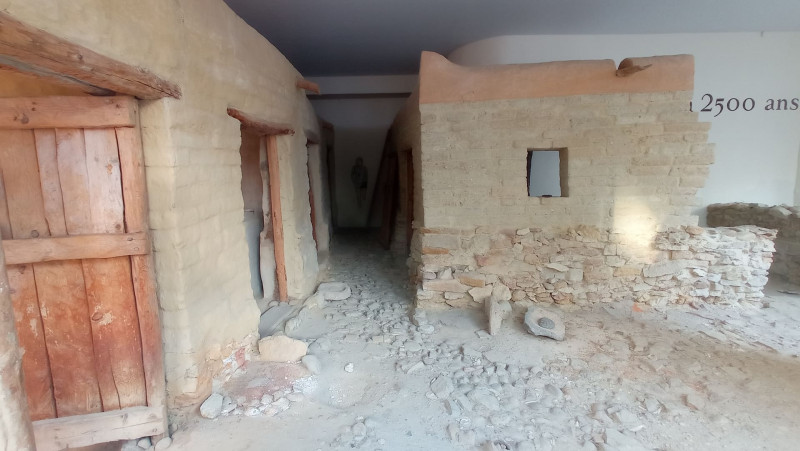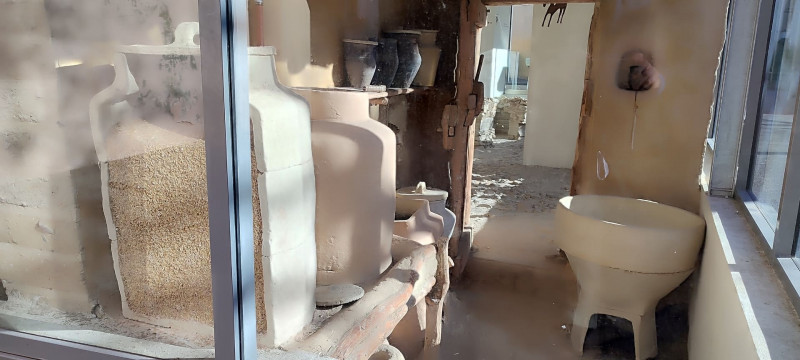Musée Vitrine Archéologique
Historic site and monumentPresentation
The archaeological showcase located on the square Maritima (district of the Island) is, on 80m2, a restitution in situ, on the remains of a primitive Gallic village (5th century before our era).
The archaeological showcase restores, in the heart of the Island, a Gallic village from the 5th century BC, discovered during emergency excavations carried out in the 1980s under what is now Place Maritima.
It reveals, in situ and at scale 1, two alleys, a small square and eight houses.
Martigues was first an island, born 2500 years ago at the crossroads of land (between Arles and Marseille) and sea (the Caronte channel between the Etang de Berre and the sea). From 1978 to 2001, major excavations revealed the evolution of its topography and human occupation. Above all, they revealed the oldest occupation: two successive Gallic villages inhabited for three and a half centuries (mid-5th - late 2nd century BC). Exceptional burial conditions (destruction by the Greeks and then the Romans, fires and submersion of the remains) have left us some of the most evocative ruins of the Mediterranean Iron Age.
Built on a site untouched by any occupation, the primitive settlement (until the beginning of the 2nd century BC) is the best known. With its rampart equipped with massive towers, it stretches over 80 meters, and is approximately 50 meters wide.
Earth architecture, this standardized habitat with single-room houses, very narrow streets, is made up of walls of molded raw bricks or massive shaped earth, raised on bases of stones taken from the surrounding hills. They are protected by a coating of clayey earth.
The floors of the houses are also covered in clay. The roofs are made of perishable materials: a wooden frame, then reeds and a thick layer of earth. These houses of 10 to 20 m² are the place for daily activities: preparation and cooking of meals, spinning, weaving, basketry, manufacturing of shaped pottery.
The activity is concentrated towards the only source of light, the door, near which, in the street, the fireplace is established. To survive, we must preserve cereals, the basis of our diet, from one harvest to the next. For this, we use ceramic containers and above all overhead silos of raw earth in various shapes shaped on site in clay mixed with plants. Alongside these "stores", other raw earth objects serve various uses: grills and ovens for processing and cooking food, urns for intermediate storage, and numerous crowns stacked in homes, probable reserves of 'clay.
In 2001, excavations under Rue de la République revealed that in the middle of the 4th century. av. BC, the habitat developed towards the East, outside the rampart, forming islands of dwellings separated by parallel streets, until the destruction of this first village. The objects and remains collected show that a Celtic population lived there living from agriculture, livestock breeding and fishing. It was very early receptive to Mediterranean cultural and technical contributions, such as viticulture and olive growing (from the 5th century BC) or the use of the potter's wheel or the practice of writing (end of the 3rd century). . before JC).
It reveals, in situ and at scale 1, two alleys, a small square and eight houses.
Martigues was first an island, born 2500 years ago at the crossroads of land (between Arles and Marseille) and sea (the Caronte channel between the Etang de Berre and the sea). From 1978 to 2001, major excavations revealed the evolution of its topography and human occupation. Above all, they revealed the oldest occupation: two successive Gallic villages inhabited for three and a half centuries (mid-5th - late 2nd century BC). Exceptional burial conditions (destruction by the Greeks and then the Romans, fires and submersion of the remains) have left us some of the most evocative ruins of the Mediterranean Iron Age.
Built on a site untouched by any occupation, the primitive settlement (until the beginning of the 2nd century BC) is the best known. With its rampart equipped with massive towers, it stretches over 80 meters, and is approximately 50 meters wide.
Earth architecture, this standardized habitat with single-room houses, very narrow streets, is made up of walls of molded raw bricks or massive shaped earth, raised on bases of stones taken from the surrounding hills. They are protected by a coating of clayey earth.
The floors of the houses are also covered in clay. The roofs are made of perishable materials: a wooden frame, then reeds and a thick layer of earth. These houses of 10 to 20 m² are the place for daily activities: preparation and cooking of meals, spinning, weaving, basketry, manufacturing of shaped pottery.
The activity is concentrated towards the only source of light, the door, near which, in the street, the fireplace is established. To survive, we must preserve cereals, the basis of our diet, from one harvest to the next. For this, we use ceramic containers and above all overhead silos of raw earth in various shapes shaped on site in clay mixed with plants. Alongside these "stores", other raw earth objects serve various uses: grills and ovens for processing and cooking food, urns for intermediate storage, and numerous crowns stacked in homes, probable reserves of 'clay.
In 2001, excavations under Rue de la République revealed that in the middle of the 4th century. av. BC, the habitat developed towards the East, outside the rampart, forming islands of dwellings separated by parallel streets, until the destruction of this first village. The objects and remains collected show that a Celtic population lived there living from agriculture, livestock breeding and fishing. It was very early receptive to Mediterranean cultural and technical contributions, such as viticulture and olive growing (from the 5th century BC) or the use of the potter's wheel or the practice of writing (end of the 3rd century). . before JC).
General information
- Client profile :
- Groups
- Environments :
- In centre of town
- Town location
- In the old centre
- Visits :
- Average individual visit length (minutes) : 15
Services, Tours, Activities and entertainment
- Individual tour services :
- Unguided individual tours available permanently
- Historical patrimony :
- Historic patrimony
- Kiosk
- Visit :
- Tour free of charge
Contact
Musée Vitrine Archéologique
Place Maritima
13500
Martigues
Phone : +33 4 42 49 03 30
Tarifs
Free access.

Destination
Musée Vitrine Archéologique
Place Maritima
13500
Martigues
GPS coordinates
Latitude : 43.40601
Longitude : 5.054531









